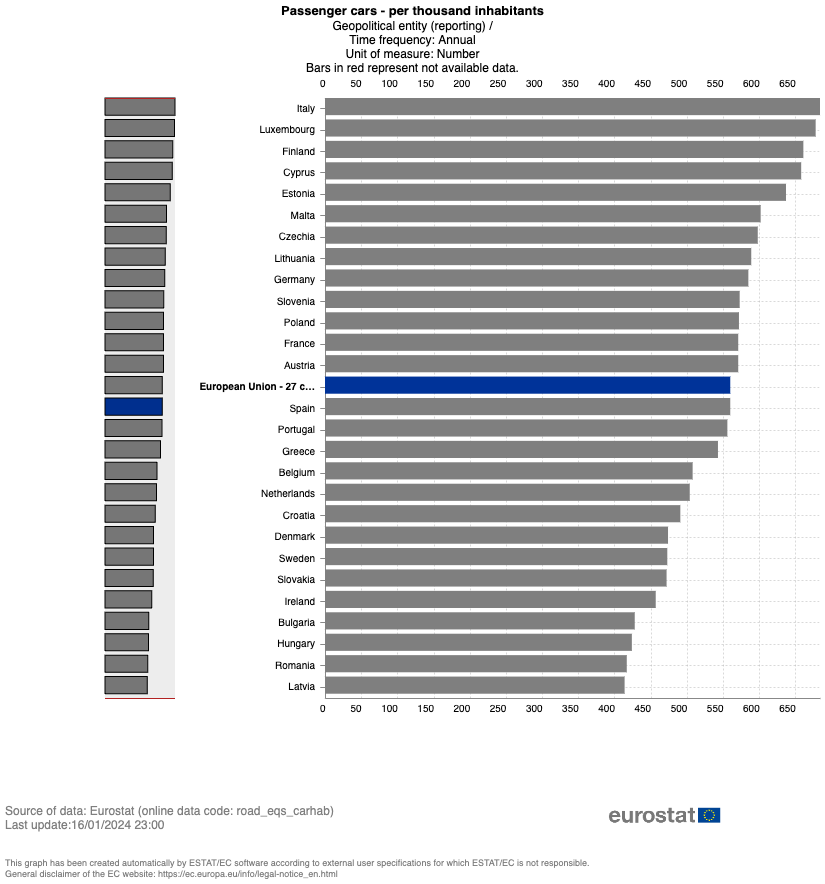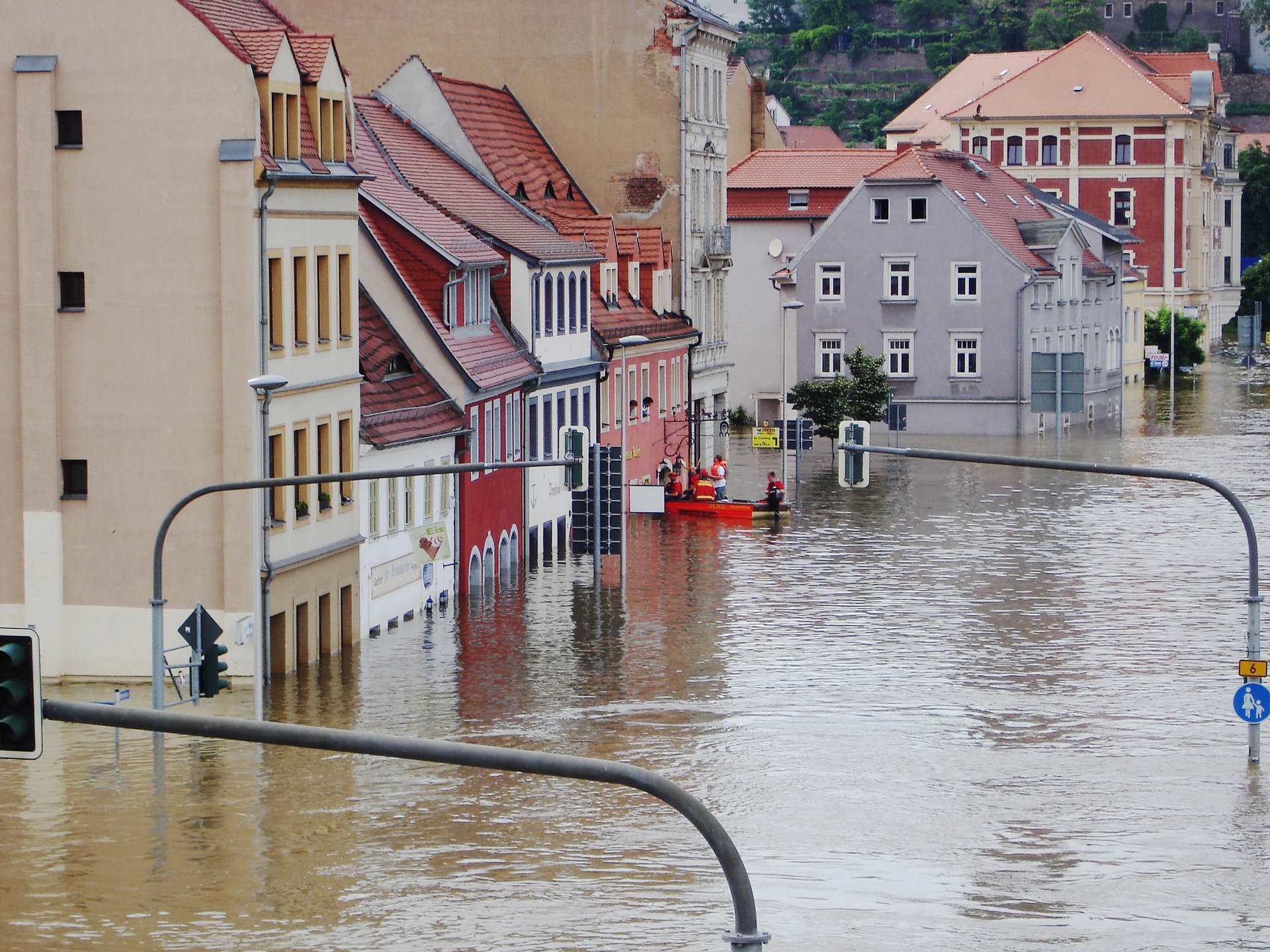The density of private transport vehicles in Italy surpassed that of Luxembourg in 2022, according to the most recent Eurostat data released (fig.1). Italy, now leading in Europe in terms of motorization rate, has 684 passenger cars per 1000 inhabitants, compared to the European average of 560.
This data, combined with those indicating that a quarter of the country’s total greenhouse gas emissions, and over a third of CO2 emissions, are due to transportation, highlight the transport sector as one of the priority areas for action when it comes to decarbonization.
Italy has scientific data available to adapt the transportation sector to the European path outlined by the Fit for 55 package, which aims to lead the old continent to reduce greenhouse gas emissions by at least 55% by 2030 in implementation of the Green Deal strategy, with the horizon of zero emissions by 2050. In light of the new recommendation by the European Commission to reduce EU emissions by 90% by 2040, the urgency for action becomes even more pressing.
The Report “Zero-impact cities: strategies and policies – Le città a impatto climatico zero: strategie e politiche” (October 2022), which gave rise to a book published by Il Mulino in 2023 and recently presented to the Chamber of Deputies of the Italian Parliament, is the latest in a series of expert reports presented by the Ministry of Infrastructure and Sustainable Mobility (MIMS) of the previous administration. It follows the Reports “Climate Change, Infrastructure and Mobility – Cambiamenti Climatici, Infrastrutture e Mobilità” and “Decarbonising Transport. Scientific evidence and policy proposals” (2022). From the three Reports, all edited, co-authored or reviewed by CMCC experts, Italy’s strong criticalities in terms of transportation sustainability can open up wide opportunities for decarbonization, if seized by the policy world.
“The great importance of the transportation sector in the context of national emissions and its strong dependence on fossil fuels make it the cornerstone of any strategy to combat climate change and protect human health,” says Carlo Carraro, member of the CMCC Strategic Committee and president of the “Climate Change, Infrastructure and Sustainable Mobility” Commission of MIMS established by former Minister Enrico Giovannini to identify concrete solutions aimed at protecting infrastructure and mobility services from climate change, while substantially reducing greenhouse gas emissions from the sector.
Mobility in Italian cities: where we stand
Cities are the location where the majority of the climate-health challenges are played out, and it is there that the goal identified by the Mission Board for climate-neutral and smart cities of reaching “100 climate-neutral cities by 2030” in Europe is embedded. The mission also involves nine Italian cities (Bergamo, Bologna, Florence, Milan, Padua, Parma, Prato, Rome, and Turin).
About half of the Italian population lives in metropolitan and large urban areas, as highlighted by the Report “Zero-impact cities: strategies and policies“, which emphasizes the age of the Italian car fleet as being very old and polluting. The median age of cars exceeds 12 years, the replacement rate is decreasing (ASSTRA – National Association of Local Public Transport Companies data), and the number of vehicles per inhabitant is increasing in six cities out of the nine involved in the Mission.
In 2021, 55% of cars and 44% of buses used for urban and extra-urban transport had an emissions class lower than Euro 5. Despite an improvement compared to the past in terms of new car registrations, in 2021, 61% of them still belonged to the ICE (Internal Combustion Engine) category, with only 4.6% being electric (compared to the European average of 11.5% and the virtuous example of Norway, which reached 75%). Looking at the entire car fleet, in the same year, 88% had traditional petrol or diesel fuel and the electric and hybrid share was 3% (of which 0.3% electric only). These elements, the authors underline, do not favor the achievement of the “zero-emission cities” objective, which can only be achieved with significant shares of public and electric vehicular mobility and active mobility on foot and by bicycle, favored by adequate infrastructures.
Electrifying road transports
The importance of electrifying road transport is clearly highlighted in the “Decarbonising Transport” Report, together with the article “How to reduce emissions and energy use for Italy’s transport sector” published in Nature Italy with contributions from CMCC. Assessing all major modes of transport – private cars, commercial vehicles, buses, trains, ships, airplanes – the available solutions, and their respective costs and opportunities, electrification emerges as the most promising technological key, especially regarding road transport, responsible for 93% of the sector’s emissions in 2019.
“There is no room for other solutions, at least in the next ten years,” says Carraro, among the authors of the two studies. “In the case of cars and light commercial vehicles, the path is marked and it is that of electric. For other modes of transportation, there are competing technologies on which choices will need to be made. In the meantime, ‘low regret’ measures can be initiated, meaning choices that involve low risks of failure. For example, expanding public charging infrastructure for electric cars certainly has a very low risk of failure, as does the construction of gigafactories for European production of state-of-the-art batteries. Similarly, reintroducing incentives for the purchase of electric cars – or disincentives for other choices – is a measure useful for mobilizing an still uncertain market and to start the path that must lead us to the emission reduction target by 2030, despite the fact that the Total Cost of Ownership of BEVs (Battery Electric Vehicles) is already better than ICEs cars today.”
Electrification, as stated in the “Climate Change, Infrastructure and Mobility” Report, must certainly go hand in hand with a profound change in mentality that allows the reduction of private vehicle use following the increase in public transport and shared mobility offers, fleet renewal, introduction of new types of vehicles, overall service improvement, and network improvement.
The cities of the future, states Pierpaolo Settembri, Head of Unit for Coordination and Planning, Directorate-General for Mobility and Transport at the European Commission, should be imagined as “cities that integrate various mobility solutions and allow a user to decide even on the same day how to move, using for example public transport in combination with a shared fleet of bicycles for the last mile, or even electric vehicles that allow the transport of multiple passengers at a time to reduce traffic congestion.”
Electrification: efficiency, costs, opportunity, life cycle
Regardless of the fuel considered, ICEs are on average 3-4 times less efficient than electric motors, and also produce various atmospheric pollutants that cause health damage, explain the authors of “Decarbonising Transport“.
“This means that by replacing particularly inefficient and polluting vehicles with zero-emission vehicles at the exhaust – typically electric cars – every ton of equivalent petroleum (tep) of fossil fuels replaced by renewable electricity requires the production of an energy equivalent of only 0.2-0.25 tep of green energy. This implies a very strong gain in terms of emissions and lower operating costs, similarly to the replacement of gas boilers with high-efficiency heat pumps,” explains Carraro.
A still debated aspect is the climate impact of electric mobility considering the entire life cycle of the vehicle. The Report shows that electric vehicles can reduce CO2 emissions by at least 37% compared to a combustion vehicle, even when considering the higher emissions resulting from their production (60 versus 33 grCO2-eq/km). The CO2 savings over the life cycle are expected to increase progressively with the decarbonization of electricity, reaching half of a combustion vehicle by 2030. In the case of heavy transport, the convenience further increases due to the greater relevance of the usage phase compared to production and end-of-life, estimating that an electric truck can save up to 70% of emissions over its entire life cycle.
BEVs, if supported through appropriate policies, are also ready to emerge as a high-adoption technology in the market. The main limiting factor, represented today by the purchase price of the vehicle, according to the Report, is already under certain conditions offset by the Total Cost of Ownership (TCO) and usage per km traveled: this happens in the case of intensive usage profiles and electricity prices in line with the past. In the presence of incentives, the gap closes even when these conditions are not fully met. Policy choices will also be necessary to accompany the installation of charging points, another well-known limiting factor.
In terms of commercialization – and particularly taking into account the efficiency, costs, and risk profile of an investment in adequate charging stations – hydrogen does not emerge as a priority option for road vehicles in the short term, although the authors encourage its pursuit as a research option. Likewise, experts dismiss other solutions including liquid biofuels from dedicated crops, classified as sustainable from an energy, economic, and environmental perspective only in limited geographical and climatic contexts, which do not include Europe or Italy.
In transforming transportation systems, the interdependencies with other sectors involved in the green transition must be considered. The extent of the benefits of a transition to electric mobility depends on the possibility of producing greenhouse gas emissions-free and low-cost electricity, as well as on the optimization and quality (durability) of on-board energy storage systems (batteries), which are the most expensive component of such technologies. In any case, even with the current energy mix, replacing internal combustion vehicles with electric vehicles would reduce light road transport emissions in Italy by 50%, highlights the Report.
For more information:
Decarbonising Transport. Scientific evidence and policy proposals – the Report
Cambiamenti Climatici, Infrastrutture e Mobilità – the Report
Le città a impatto climatico zero: strategie e politiche – the Report
La Decarbonizzazione dei Trasporti – Carlo Carraro’s blog
Decarbonising transports in Italy – CMCC website
Cambiamenti climatici, infrastrutture, mobilità – CMCC website
La transizione ecologica. Dai trasporti agli investimenti al capitale umano – Carlo Carraro’s blog







